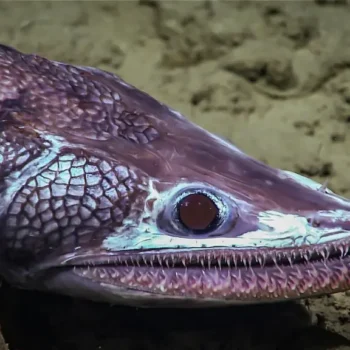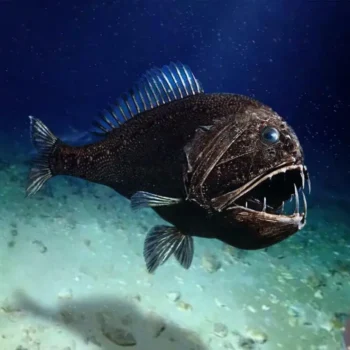Imagine a creature lurking in the deepest, darkest parts of the ocean, so large and elusive that for centuries, it was merely a legend. We’re talking about the Colossal Squid (Mesonychoteuthis hamiltoni), a true giant of the deep and one of the most fascinating animals on Earth. This article aims to shed some light on this incredible creature, making its secrets accessible to everyone.
What Exactly Is a Colossal Squid?
The Colossal Squid is a species of squid that is believed to be the largest invertebrate on Earth. It’s a member of the Cranchiidae family, also known as glass squids, but dwarfing even its closest relatives. Found primarily in the frigid waters of the Antarctic Ocean, this behemoth is a formidable predator and a vital part of the deep-sea ecosystem.
Size and Dimensions: How Big Is It Really?
Determining the exact size of a Colossal Squid is challenging since complete specimens are rare. Most estimates are based on fragments, especially beaks found in the stomachs of sperm whales. However, scientists estimate that the Colossal Squid can reach lengths of 12-14 meters (39-46 feet) and weigh up to 750 kilograms (1,650 pounds). This makes it heavier, though not necessarily longer, than the better-known Giant Squid.
Distinguishing Features: How to Spot a Colossal Squid
While both Colossal Squid and Giant Squid are impressive, they have distinct characteristics that set them apart.
- Hooks vs. Suckers: Unlike the Giant Squid, which has suckers lined with toothed rings, the Colossal Squid possesses rotating hooks on its arms and tentacles. These hooks help it grip prey in the cold, slippery environment of the Antarctic.
- Larger Eyes: The Colossal Squid boasts the largest eyes of any animal, thought to be up to 27 cm (11 inches) in diameter. These enormous eyes are perfectly adapted for detecting faint bioluminescence in the dark depths of the ocean.
- Stockier Build: While both species are large, the Colossal Squid is generally believed to have a more robust and heavier body than the Giant Squid.
Habitat and Diet: Where Do They Live and What Do They Eat?
The Colossal Squid resides primarily in the deep waters surrounding Antarctica. Its habitat is characterized by extremely cold temperatures and immense pressure. These squids are thought to inhabit depths ranging from 300 to 2,200 meters (980 to 7,220 feet).
 Deep-Sea Lizardfish Explained: Unveiling the Ocean’s Alien Predator
Deep-Sea Lizardfish Explained: Unveiling the Ocean’s Alien PredatorAs for their diet, Colossal Squid are apex predators in their environment. Their main prey includes:
- Antarctic toothfish
- Other squid species
- Deep-sea fish
They use their sharp hooks and powerful tentacles to capture prey, bringing it to their beak-like mouth for consumption.
Scientific Discoveries and Research
Due to their elusive nature, studying Colossal Squid is incredibly difficult. Most of our knowledge comes from analyzing specimens caught accidentally by fishing vessels or found in the stomachs of sperm whales. However, each new discovery provides valuable insights into their biology, behavior, and role in the ecosystem.
A Notable Specimen: The 2007 Capture
One of the most significant events in Colossal Squid research occurred in 2007 when a complete specimen was caught by fishermen in the Ross Sea. This squid, estimated to weigh around 495 kilograms (1,091 pounds), was carefully frozen and later thawed for scientific examination. This provided researchers with an unprecedented opportunity to study the anatomy and physiology of this enigmatic creature.
Conservation Status: Are Colossal Squid Threatened?
Currently, the Colossal Squid is not listed as threatened or endangered. Its remote habitat and deep-sea lifestyle likely offer some protection from human activities. However, potential threats include:
 Fangtooth Fish Explained: Unveiling the Deep Sea’s Fearsome Predator
Fangtooth Fish Explained: Unveiling the Deep Sea’s Fearsome Predator- Climate Change: Changing ocean temperatures and acidification could impact the Colossal Squid’s prey and habitat.
- Overfishing: Depletion of prey species like the Antarctic toothfish could affect the Colossal Squid’s food supply.
- Bycatch: Accidental capture in fishing nets remains a possibility.
Ongoing research and monitoring are essential to ensure the long-term conservation of these magnificent creatures.
The Future of Colossal Squid Research
Many mysteries surrounding the Colossal Squid remain unsolved. Future research efforts will likely focus on:
- Developing advanced tracking technologies to monitor their movements in the deep sea.
- Conducting further genetic studies to understand their evolutionary relationships.
- Investigating their sensory capabilities and how they navigate the dark ocean depths.
By continuing to explore the depths of the ocean, we can unlock the secrets of the Colossal Squid and gain a greater appreciation for the biodiversity of our planet.




